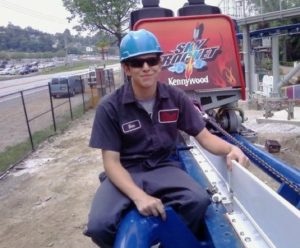 Today we continue our interview with Penn State Mechanical Engineering student Dan Guy. In case you missed it, click here to read part one.
Today we continue our interview with Penn State Mechanical Engineering student Dan Guy. In case you missed it, click here to read part one.
C101: How complicated is it to drive the monorail at Walt Disney World? Doesn’t it have a sophisticated computer monitoring system to help prevent collisions?
Dan: Just like everything, it took some practice to get the hang of. Every pilot has to go through a week of training and at the end you have to pass a test to officially be able to drive on your own. The only difficult part I found with the job was complying with the MAPO system, which is the name of the monorail’s blocking system. Before becoming a pilot, you have to memorize a list of over 100 holdpoints which help ensure there is adequate spacing between all the trains. At any given time, there has to be at least two hold points between each train, and the moment there isn’t, the train is e-stopped. Getting an “overrun” is probably the worst thing you can do as a pilot, and all the CPs feared getting one. It is vital to have these holdpoints memorized because it ensures you know where you have to stop the train if you are too close to the train in front.
Other than that, it’s really not complicated at all to drive the monorails. The speed is controlled by a single lever, so the only thing the pilot has to be concerned with is staying within the speed limit and listening to the radio to know what’s going on around the monorail system. The only time it really got complicated is when a train got a fault and there were certain procedures that had to be performed to get the train moving again and to the next station. There was definitely a lot that went into piloting, but once I got the hang of it, I’d probably say it was a lot more fun to operate than your standard amusement park ride. You have a lot more control of what’s going on, it’s not like you just push a button and the train drives itself. At the time, we were also allowed to have guests in the front cab, so having the opportunity to talk to people while I drove made the experience even more enjoyable.
C101: What was your role during your professional internship at Disney? Can you talk about any of the projects you worked on?
Dan: I was a professional intern at Disney’s Animal Kingdom’s Facilities Engineering department. This internship was a little different than the rest of my experiences because it had nothing to do with amusement rides. I dealt primarily with the facilities in the Animal Kingdom region, which included the park and its three resorts: Animal Kingdom Lodge, Coronado Springs Resort, and all three All-Star Resorts. I did a lot of projects that involved reading and analyzing engineering drawings and compiling them in a user-friendly manner so that if someone needed to locate a certain asset within the park, they wouldn’t have to go digging through tons of drawings to find it.
I also worked on two design projects which were great learning experiences because I actually got to design something, go out and get bids for it, and even see it be built into a physical object for one of them. For that project I was tasked to redesign the bamboo/eucalyptus fence surrounding the Oasis area at the park entrance. Several safety standards have been updated since the park opened in 1997, and I was tasked to redesign this fence to meet the new standards. This involved lots of measuring out on the field, determining which areas of the fence needed updated, and creating design drawings that could be used to build this fence. Towards the end of my internship, they had actually started to build the new fence using my new design, and as of March the entire perimeter of the Oasis area had been rebuilt. I had the opportunity to visit the park recently and the satisfaction I felt from seeing something I designed be built into a physical object that will be seen by millions of people every year is just indescribable. Even if it is something as small and simple as a fence, how many people can say that they designed something at a Disney park that they can show off to their friends?
C101: You’re also involved in a theme park engineering group, correct? Can you tell us a little about the group and what they do? Any interesting projects?
Dan: Correct. I’ve been a member ofPennState’s Theme Park Engineering Group since its inception a year or two ago when I first got an email about it. The group didn’t really get up and running with meetings and everything until last spring, but due to me being at Disney, I really didn’t get involved in the group until this past fall semester. As for the group itself, it’s nothing more than a bunch of theme park nerds who are passionate about the industry like myself, and want to apply the knowledge they have gained in school to applications within the industry. We’ve also done a lot over the last two semesters to stress the importance of networking with leaders within the amusement industry. Last semester, we sent down a few people including myself to the IAAPA Expo in November. It was here where we learned about ASTM F24 from the Ohio State Group and Jim Seay of Premier Rides, so several of the people who were at IAAPA also attended the most recent ASTM F24 meeting inFt.Lauderdale just a few weeks ago.
We’ve also done a number of tours of amusement related facilities. Last semester we took a tour of the Great Coasters International office inSunbury,PA.We also recently visited the construction site of Skyrush at Hersheypark and are taking a tour of the facilities of the R.S. Alberts Company, who produce a lot of the restraints used on amusement rides throughout the country. Of course, our schedule is constantly being adjusted and we are always looking for new opportunities to check out.
I’ll try not to bore you with too much detail on the types of projects we are working on, but right now we are working on an original design project between four different groups. What we did was send out a survey to find out what kind of ride most people tend to like, or one that they’d really like to see become reality. We compiled the data and picked out the top five ride types, features, and several other categories. In groups we’ve been developing original rides that meet at least one of each of these categories and in the next few weeks or so we are going to be presenting our projects to a panel of engineering faculty to determine which original design we’d like to expand upon even more. Our goal throughout this process has been to almost simulate Disney’s ImagiNations competition. I know several of the people in our group are very serious about taking part in ImagiNations in the future, so this project has definitely given us some experience in developing our own ride. It’s also allowed us to express our creativity, which is something that you don’t normally get to do in your typical engineering courses.
If you’re interested, feel free to check out our website at: http://www.psuthemeparkengineering.com
C101: What advice would you offer to anyone younger than yourself looking to get into the industry? What’s the best and/or worst advice you’ve been given?
Dan: Well, I would start by saying that if you have a passion for this industry and the type of work involved, go for it! I don’t know how many times I’ve heard people tell me how small the industry is and how low my chances of getting a job are, but I’ve stuck with it and have done pretty well so far. One thing about the amusement industry is that, especially in regards to engineering positions, it’s nothing like the other industries out there. While you almost always see companies like General Motors, Siemens, General Electric, etc. at your career fairs, you almost never see companies representing amusement parks or amusement ride companies. I personally don’t feel the industry is as small as people claim, because the opportunities are there. It is just a matter of you getting out there, meeting people within the industry, and getting your name known. Most people wouldn’t be willing to fly to other states multiple times throughout the year to attend expos and meetings in order to get a job, but quite frankly, to get into this business it is necessary. These people aren’t going to come looking for you, you need to seek them out and show them how much you want to work in the business. One thing Chris Gray at GCI told all of us on our tour was that if we really wanted to get into this business, we had better be at IAAPA every single year. It is all a matter of getting your name known and keeping in touch with these people. Everyone knows everyone in this business, so making several good relationships with leaders in the industry can do wonders for you.
Also, if you get the opportunity to work anywhere in the industry, make the most of it! Most people only go to work, perform their duties, and go home. Any position I have held in this industry, I did my best to learn as much as I could, whether it be learning rides that weren’t mine at Kennywood, or learning about other positions available at Disney. I am the type of person who seeks out new information anywhere I go, so this has been very beneficial to me in getting into the industry. If you get a job working at an amusement park, don’t be afraid to ask someone if you have questions. You don’t know how many times I had a ride op ask me how a certain part of a ride functions, and it always put a smile on my face getting to share my knowledge with others. And when a new opportunity presents itself, don’t hesitate to take it!
C101: As someone who has been to both, what is the difference between the IAPPA expo and the ASTM conference? I’ve heard the atmosphere is completely different – that IAPPA is a lot more “intense.”
Dan: To put it simply, IAAPA is a business environment. Ride vendors are there to show off and sell their rides to park officials in attendance. While some companies are very friendly and eager to talk to visitors who aren’t there to buy, for the most part, many of the larger companies are there strictly to talk business. Don’t get me wrong, I think everyone interested in starting a career in the business should take a trip to IAAPA at least once, but if you do go, don’t go in thinking you’re going to land a job or even an internship. While it wouldn’t hurt to have a few copies of your resume on hand just in case, IAAPA is definitely not a place for you to go around handing out resumes. However, it is good to go around and talk with as many people as possible. The industry is small and you will see that everyone knows just about everyone. Getting your name out there is a great first step if you’re trying to get into the industry. Aside from that, IAAPA is still very much a fun event to attend. There’s lots of free food, games, and rides to keep you busy for a few days. One thing I can definitely say about IAAPA is that it is definitely a little overwhelming for first time visitors, but still very much worth the trip.
As for ASTM, it is definitely a lot more laid back than IAAPA. For starters, everyone is there voluntarily to help improve the standards involved in all facets of the amusement industry. There are task force meetings for everything from acceleration limits, to operations, to restraints. Visitors are free to walk in and out between meetings and it is a great experience for people new to the industry. You also have the opportunity to talk to some of the most influential figures in the industry who aren’t busy trying to buy or sell a new ride. I went down to the most recent ASTM meeting with a few people from the Penn State Theme Park Engineering Group, and for the most part our group was very well received by most people in attendance. I can’t tell you how many individuals came up to us asking us questions about our group and taking the time out of their schedules to talk with us. This was all very surprising to us after attending IAAPA only a few months earlier, where some people were reluctant to even speak with us since we weren’t buying anything. Don’t get me wrong, I’d recommend attending both events if you’re interested in getting into this business, but for me ASTM was probably the more positive of the two experiences.
C101: So after having all of these amazing experiences, where do you go from here? Do you have any future plans (schedule or timeline)?
Dan: As I mentioned before, I am actually graduating this coming December so my goal has been to get as much work experience as possible before then. I recently interviewed with several companies for summer internships after attending ASTM, and just recently accepted a summer internship with Premier Rides for the summer. So those two things are probably the biggest of my plans for the remainder of the year. Where I go after graduation is anyone’s guess, but hopefully I can land a full time job somewhere within the industry! However, my focus right now is finishing off the rest of this semester, and getting ready to start my internship with Premier in May.
C101: Congratulations on getting the internship with Premier and good luck in all your future endeavors.

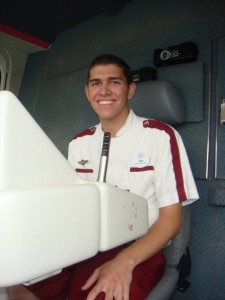
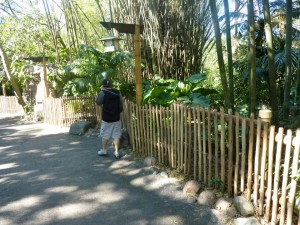
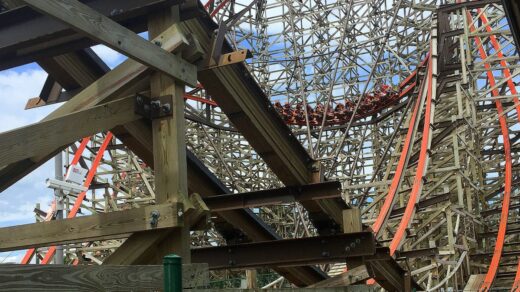
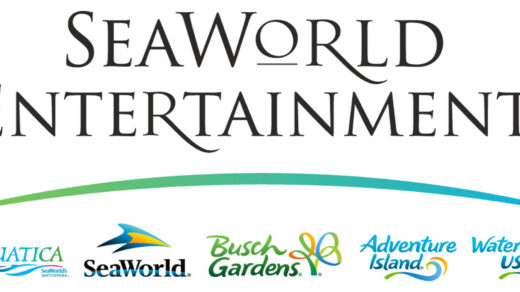
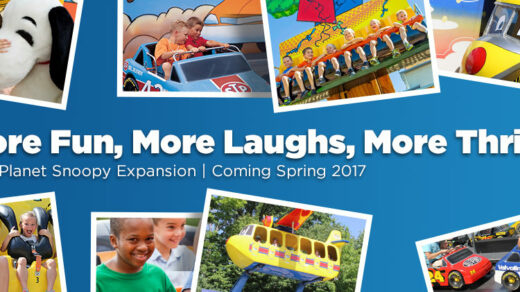





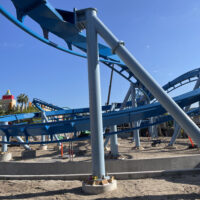





Recent Discussion